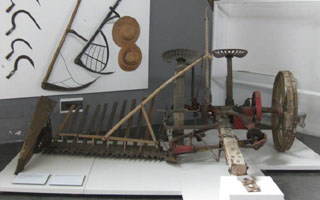Harvest

Wheat was traditionally harvested at the end of June. This had to be done at just the right time, before storms or hail ruined the yield.
The entire family participated in the harvest, often joined by wage laborers. When threshing was still done by hand, workers used harvesting sickles with short handles (sagguel, siglénna) to chop the stems at the neck; when done with a threshing machine, the cut was made closer to the ground. The cut bundles (manvì) were deposited on the stem stubble and left on the ground for a few days to dry. Three or four bundles together formed a sheave that was tied together with a cord made of sedge (pavira) or a hemp stem (canvèla). The sheaves were loaded with pitchforks unto a wagon and transported to the farmyard, where they were stored under the portico of the stables or set out in the open in a haystack known as a “bica” (bèrch, cavaiòn).
The short-handled harvesting sickle was the main tool used for harvesting grain until the middle decades of the 1900s, when it was replaced by an animal-drawn sickle (sgadòura). The blacksmiths of the countryside applied a special device (aparàcc’ da méder) that gathered the stems and left them in the right quantities to form a sheave. A child seated on the machine would drop (fèr l óca) a hemp stem for tying the bundles; workers would then follow along to form sheaves and move them aside. The wheat positioned on the perimeter of the farm was cut by hand with a hay sickle equipped with a tool that prevented the grain from falling in a dispersive manner (fèr da sghèr còn l aparàcc’ da méder), thus allowing the animal-drawn sickle to pass without damaging the harvest.